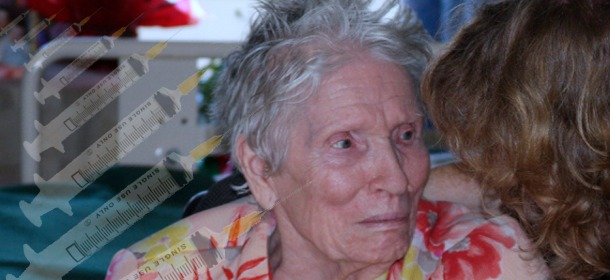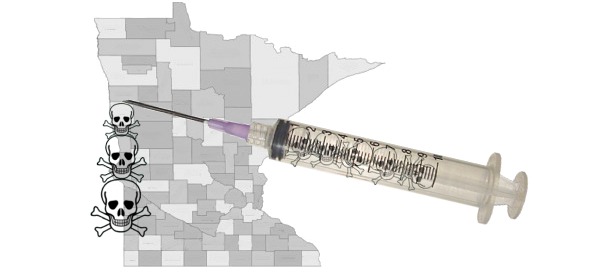Diseases/Conditions
Drugs for Glue Ear Cause Pain, Shortness of Breath, Gut Hemorrhage, and Much More
Parents whose children suffer with glue ear (otitis media effusion) may soon be urged to give them cancer chemotherapy instead of surgically implanting drainage tubes. It’s being hailed as a cure, but the enormous and deadly risks—suffered by the vast majority given the drugs—are evaded.
The drugs in question are called VEGF (vascular endothelial growth factor) inhibitors. VEGF is a polypeptide that stimulates the growth of blood vessels. Thus, VEGF inhibitors prevent the growth of blood vessels. This is believed to be useful in cancer treatment, because it prevents the growth of extra blood near a tumor, which may help starve it. Even when effective, though, the treatment comes at an enormous price in adverse effects.
The VEGF class of drugs includes, but may not be limited to:
- Avastin (bevacizumab)
- Macugen (pegaptanib)
- Lucentis (ranibizumab)
Go to the end of the article* to see a complete list of the common adverse effects. In summary, nearly three-fourths of patients experience weakness, nearly two-thirds experience pain, a full fourth experience shortness of breath, and nearly a fourth suffer from gastrointestinal hemorrhage—not just bleeding, but massive and potentially deadly bleeding. Other potentially deadly effects include severely low white blood cell counts, thrombosis, and diarrhea with blood stools. Note that the list includes only those adverse effects known to occur in over 10% of patients.
Yet, treatment with these incredibly dangerous drugs is being hailed as a “noninvasive” cure! They’re saying that they’ll apply the drug directly into the ear, which they claim should eliminate or significantly cut back on what they euphemistically call side effects. They don’t mention that the drug must still be cleared through the child’s metabolism. There isn’t a snowball’s chance of the adverse effects being eliminated.
It’s interesting that drugs that can cause such devastation are being termed “noninvasive”. Dr. Ian Williamson, a senior lecturer in general practice at the University of Southampton and an adviser to Deafness Research UK, called the study a significant scientific advance. He said:
By developing genetic disease models for glue ear, the research team have gained new insights into potential ways of identifying children at risk.
That is, potentially, the most terrifying aspect of this story. Williamson obviously believes that children who might someday suffer from glue ear should be pressed into this treatment when it becomes available. That he’s an advisor to Deafness Research UK heightens that concern.
Research Status
Otitis media effusion is an inflammatory process that results in a collection of fluid in the middle ear. The vast majority of these cases are self-limiting and clear up rapidly. A few children have an ongoing problem with them. The fluid can build up and become thick, ultimately leading to hearing impairment.
The theory behind the VEGF cancer drug research is that the key cause behind glue ear is hypoxia, a lack of oxygen in the middle ear. They surmise that the lack of oxygen prevents the resolution of otitis media inflammation. Professor Steve Brown, director of the Medical Research Council and the lead researcher in the study, stated:
This lack of oxygen, known as hypoxia, appears to prevent the inflammation in the middle ear resolving, allowing fluid to build up, which can impair hearing.
By using existing drugs that tackle the root causes of hypoxia, we have been able to significantly reduce hearing loss and the build-up of fluid in the middle ear of our mouse models.
The hypoxia is alleviated by the VEGF cancer drugs. These drugs also reduce the number of blood vessels. There’s a conflict here. Blood is required to carry oxygen to tissues. VEGF inhibitors prevent the formation of blood vessels. Thus, the very means of carrying oxygen to the middle ear is being damaged by the drug that also increases oxygen.
At this point, research has been done on mice that had been mutated to be prone to otitis media effusion. They rather cutely call these mutants Junbo and Jeff. (What? Not Mutt and Jeff?) Thus far, no one has suggested that children who suffer from glue ear are also deviants, but we’ll leave that aside.
The research done by Steve Brown and his cohorts demonstrated that using VEGF inhibitors reduces blood vessel and lymph generation. Adverse effects were either not considered or not reported. No consideration was given to long term effects. It was presumed that local application would limit adverse effects, but there is no backup for that assumption.
The authors anticipate that human (child) trials are likely within five years.
Where’s the Sense Behind this Study?
The contrast between loss of blood vessels and increased oxygen could prove to be critical. Oxygen is brought to cells through blood in blood vessels. Yet, the authors are suggesting that giving a drug that limits the growth of blood vessels alleviates hypoxia. Though it appears that the drug does so, it is also destroying the ability to grow and maintain blood vessels, which are, ultimately, necessary to bring oxygen to the area. Thus, this approach must ultimately make the problem worse. Either blood vessels will be grown through other means—which is, in fact, what happens, but isn’t a normal method—or blood vessel growth is stunted.
They also suggest that the drug’s ability to limit growth of lymph vessels is also beneficial. However, lymph vessels are the body’s natural drainage system. It’s how most toxins are eliminated. So, how does forcing the body to cut back on the number of lymph vessels improve the ability to heal?
No consideration is being given to long term effects.
Questions that need to be asked are:
- What will be the effects of the resurgence of blood vessel growth? It is already known that the body will utilize other biological pathways when VEGF is blocked.
- What are the long term effects of the drugs involved? We are, after all, talking about children.
- Will the effects of the drugs or resurgence of blood vessel growth ultimately result in worsening of the problem, so that more children will lose hearing?
- On what basis is this potential treatment being considered an improvement on surgery?
Professor Brown claims that this research addresses the root causes of glue ear. The truth, though, is quite different. Unless the causes of glue ear are addressed, this problem will continue, and the more it’s treated by pharmaceutical drugs, the worse it will become. There’s a reason for those blood vessels in the middle ear. Reducing their number through chemotherapy is not addressing the root cause.
Defining normal blood vessel development as abnormal, simply because it’s inconvenient in this context, is not addressing the root cause. It’s merely pointing a finger at a target and saying, “If we can eradicate this, then we can fix the problem.” It ignores the fact that those blood vessels are there for a reason. It ignores the fact that the body is already known to find a way around the effects of the treatment. In fact, it completely ignores the real issue: What external forces cause glue ear? Could it be the antibiotics that are so often given for the infections? Could it be pollution? Could it be allergies? Could it be vaccines? The fact is that we don’t know—and neither do the authors of this trial.
Defining an effect—a symptom—of the problem is not identifying the cause.
Adverse Effects
*According to Medscape, known adverse effects, including only ones that occur in over 10% of patients, are:
- Weakness (73-74%)
- Hypertension (23-67%, severe: 8-18%)
- Pain (61-62%)
- Abdominal pain (50-61%, severe: 8%)
- Vomiting (47-52%, severe: 6-11%)
- Upper Respiratory Infection (40-47%)
- Constipation (29-40%)
- Leukopenia (decrease in white blood cells, severe: 37%)
- Neutropenia (decrease in most important white blood cells, severe: 6-27%)
- Proteinuria (36%, severe—indicative of kidney failure: 3%)
- Epistaxis (nosebleeds 32-35%)
- Diarrhea (including bloody stools, severe: 2-34%)
- Stomatitis (mouth inflammation 30-32%)
- Alopecia (hair loss 6-32%)
- Headache (26%; severe: 2-4%)
- Shortness of breath (25-26%)
- Dizziness (19-26%)
- GI hemorrhage (19-24%)
- Dyspepsia (17-24%)
- Taste alteration (indicative of neurological damage14-21%)
- Exfoliative dermatitis (3-19%)
- Fatigue (severe: 5-19%)
- Flatulence (11-19%)
- Neuropathy (severe: 1-17%)
- Lacrimation disorder (6-18%)
- Weight loss (15-16%)
- Hypokalemia (low potassium, potentially deadly12-16%)
- Skin discoloration (2-16%)
- Thromboembolic events (severe: 15%)
- Myalgia (muscle pain 8-15%)
- Hypotension (low blood pressure 7-15%)
- Nausea (severe: 4-12%)
- Back pain (undefined)
With a list of adverse effects like this, it’s obvious that most children will suffer from a potentially life-threatening or debilitating disorder as a result of taking a VEGF drug. And that doesn’t even consider the effects of forcing a reduction of blood and lymph vessels to the area.
References:
- HIF–VEGF Pathways Are Critical for Chronic Otitis Media in Junbo and Jeff Mouse Mutants
- Study Links Hypoxia and Inflammation in Many Diseases
- ‘Glue ear’ treatment could see ‘end to grommet surgery’
- Scrap the grommets: Glue ear could soon be treated with drug, avoiding operations for thousands
- Potential new treatments for a common childhood hearing disorder
- Glue ear – Causes
Tagged adverse effects, big pharma, cancer drugs, chemotherapy, glue ear, glue ear cancer drug, glue ear chemotherapy, modern medicine, otitis media, otitis media chemotherapy, pharmaceutical drugs, pharmaceuticals
Related Posts
-
Anonymous
-
Anonymous
-
















